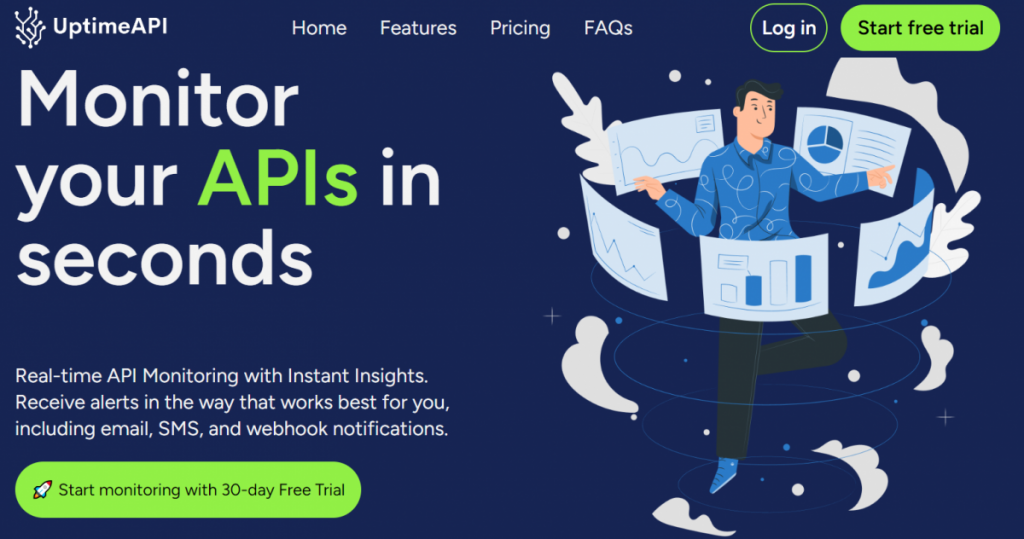In the fast-paced world of software development, ensuring the reliability and performance of your applications is paramount. Downtime can lead to frustrated users and potential financial losses. This is where Real Time API Monitoring comes into play, and one tool that stands out in this domain is UptimeAPI. In this tutorial, we’ll explore the importance of real-time API monitoring and guide you through the process of setting up and using UptimeAPI.
Why Real-Time API Monitoring Matters

Before we delve into the specifics of UptimeAPI, let’s understand why real-time API monitoring is crucial for developers.
- Instant Issue Detection: Real-time monitoring allows you to identify issues the moment they occur, enabling rapid response and minimizing downtime.
- Performance Optimization: Monitoring your API in real-time provides insights into performance bottlenecks, allowing you to optimize and enhance the overall user experience.
- Enhanced User Satisfaction: Users expect seamless interactions with applications. Real-time monitoring ensures that you can proactively address issues, keeping your users happy and engaged.
- Cost-Efficiency: Identifying and resolving issues promptly can save resources and costs associated with prolonged downtimes and reactive problem-solving.
Introducing UptimeAPI
UptimeAPI is a comprehensive real-time API monitoring solution designed to provide developers with the tools they need to ensure the reliability and performance of their APIs. With features like instant alerts, historical data analysis, and easy integration, UptimeAPI is a valuable asset in any developer’s toolkit.
Setting Up UptimeAPI
Follow these simple steps to set up UptimeAPI for your API monitoring needs:
1. Sign Up for UptimeAPI Account
Visit the UptimeAPI website and sign up for an account. Once registered, you’ll gain access to the dashboard where you can start adding your APIs for monitoring.
2. Add Your API Endpoints
In the dashboard, navigate to the “Add New Monitor” section. Here, you’ll enter the details of your API, including the endpoint URL and monitoring intervals. UptimeAPI allows you to customize the monitoring frequency based on your specific requirements.
3. Configure Alert Preferences
UptimeAPI offers various alert notification options, including email, SMS, and integrations with popular communication platforms like Slack. Configure your alert preferences to ensure that you are promptly notified of any issues with your API.
4. Generate API Key
To enable communication between your application and UptimeAPI, generate an API key from the dashboard. This key will be used to authenticate requests and allow UptimeAPI to monitor your API effectively.
5. Integrate UptimeAPI into Your Application
Utilize the provided documentation and code snippets to integrate UptimeAPI into your application. This step ensures that UptimeAPI can actively monitor your API and provide real-time insights into its performance.
Understanding API Responses with UptimeAPI

One of the key features of UptimeAPI is its detailed reporting on API responses. When an issue is detected, UptimeAPI captures and analyzes the API response, providing valuable information for developers to identify and resolve the problem.
Here’s what you can expect from UptimeAPI’s API response analysis:
- HTTP Status Codes: UptimeAPI records the HTTP status codes returned by your API. This helps you quickly identify whether the API request was successful or encountered an error.
- Response Time: The response time of your API is crucial for user experience. UptimeAPI monitors and logs the time it takes for your API to respond, allowing you to identify performance bottlenecks.
- Error Messages: In the event of an error, UptimeAPI captures and logs any error messages returned by your API. This information is invaluable for debugging and resolving issues promptly.
- Historical Data: UptimeAPI stores historical data on API responses, enabling you to track trends and identify patterns in your API’s performance over time.
Conclusion
Real-time API monitoring is a game-changer for developers, providing the means to detect and address issues promptly, optimize performance, and enhance user satisfaction. UptimeAPI, with its user-friendly interface and powerful features, makes it easy for developers to implement robust monitoring for their APIs.
By following the simple setup process outlined in this tutorial, you can integrate UptimeAPI into your applications, ensuring that you stay ahead of potential issues and deliver a seamless user experience. Remember, real-time monitoring is not just about avoiding downtime; it’s about creating a reliable and performant application that users can trust.
Incorporate UptimeAPI into your development workflow today and experience the peace of mind that comes with real-time API monitoring. Your users will thank you, and your applications will run smoother than ever before.
Read More: Company profile APIUsage Cases

